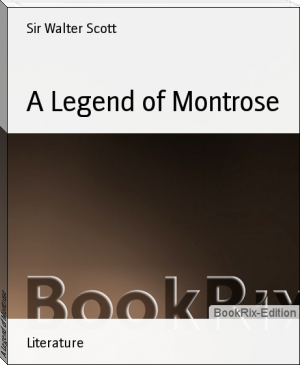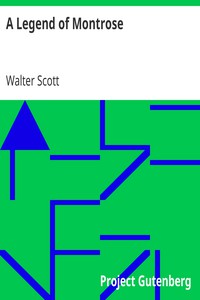Rob Roy — Complete, Walter Scott [top fiction books of all time txt] 📗

- Author: Walter Scott
Book online «Rob Roy — Complete, Walter Scott [top fiction books of all time txt] 📗». Author Walter Scott
* This fatal piece was taken from Robin Oig, when he was seized many years afterwards. It remained in possession of the magistrates before whom he was brought for examination, and now makes part of a small collection of arms belonging to the Author. It is a Spanish-barrelled gun, marked with the letters R. M. C., for Robert MacGregor Campbell.
He was as good as his word, and shot MacLaren when between the stilts of his plough, wounding him mortally.
The aid of a Highland leech was procured, who probed the wound with a probe made out of a castock; i.e., the stalk of a colewort or cabbage. This learned gentleman declared he would not venture to prescribe, not knowing with what shot the patient had been wounded. MacLaren died, and about the same time his cattle were houghed, and his live stock destroyed in a barbarous manner.
Robin Oig, after this feat—which one of his biographers represents as the unhappy discharge of a gun—retired to his mother's house, to boast that he had drawn the first blood in the quarrel aforesaid. On the approach of troops, and a body of the Stewarts, who were bound to take up the cause of their tenant, Robin Oig absconded, and escaped all search.
The doctor already mentioned, by name Callam MacInleister, with James and Ronald, brothers to the actual perpetrator of the murder, were brought to trial. But as they contrived to represent the action as a rash deed committed by “the daft callant Rob,” to which they were not accessory, the jury found their accession to the crime was Not Proven. The alleged acts of spoil and violence on the MacLarens' cattle, were also found to be unsupported by evidence. As it was proved, however, that the two brothers, Ronald and James, were held and reputed thieves, they were appointed to find caution to the extent of L200, for their good behaviour for seven years.*
* Note D. Author's expedition against the MacLarens.
The spirit of clanship was at that time, so strong—to which must be added the wish to secure the adherence of stout, able-bodied, and, as the Scotch phrase then went, pretty men—that the representative of the noble family of Perth condescended to act openly as patron of the MacGregors, and appeared as such upon their trial. So at least the author was informed by the late Robert MacIntosh, Esq., advocate. The circumstance may, however, have occurred later than 1736—the year in which this first trial took place.
Robin Oig served for a time in the 42d regiment, and was present at the battle of Fontenoy, where he was made prisoner and wounded. He was exchanged, returned to Scotland, and obtained his discharge. He afterwards appeared openly in the MacGregor's country; and, notwithstanding his outlawry, married a daughter of Graham of Drunkie, a gentleman of some property. His wife died a few years afterwards.
The insurrection of 1745 soon afterwards called the MacGregors to arms. Robert MacGregor of Glencarnoch, generally regarded as the chief of the whole name, and grandfather of Sir John, whom the clan received in that character, raised a MacGregor regiment, with which he joined the standard of the Chevalier. The race of Ciar Mhor, however, affecting independence, and commanded by Glengyle and his cousin James Roy MacGregor, did not join this kindred corps, but united themselves to the levies of the titular Duke of Perth, until William MacGregor Drummond of Bolhaldie, whom they regarded as head of their branch, of Clan Alpine, should come over from France. To cement the union after the Highland fashion, James laid down the name of Campbell, and assumed that of Drummond, in compliment to Lord Perth. He was also called James Roy, after his father, and James Mhor, or Big James, from his height. His corps, the relics of his father Rob's band, behaved with great activity; with only twelve men he succeeded in surprising and burning, for the second time, the fort at Inversnaid, constructed for the express purpose of bridling the country of the MacGregors.
What rank or command James MacGregor had, is uncertain. He calls himself Major; and Chevalier Johnstone calls him Captain. He must have held rank under Ghlune Dhu, his kinsman, but his active and audacious character placed him above the rest of his brethren. Many of his followers were unarmed; he supplied the want of guns and swords with scythe-blades set straight upon their handles.
At the battle of Prestonpans, James Roy distinguished himself. “His company,” says Chevalier Johnstone, “did great execution with their scythes.” They cut the legs of the horses in two—the riders through the middle of their bodies. MacGregor was brave and intrepid, but at the same time, somewhat whimsical and singular. When advancing to the charge with his company, he received five wounds, two of them from balls that pierced his body through and through. Stretched on the ground, with his head resting on his hand, he called out loudly to the Highlanders of his company, “My lads, I am not dead. By G—, I shall see if any of you does not do his duty.” The victory, as is well known, was instantly obtained.
In some curious letters of James Roy,* it appears that his thigh-bone was broken on this occasion, and that he, nevertheless, rejoined the army with six companies, and was present at the battle of Culloden.
* Published in Blackwood's Magazine, vol. ii. p. 228.
After that defeat, the clan MacGregor kept together in a body, and did not disperse till they had returned into their own country. They brought James Roy with them in a litter; and, without being particularly molested, he was permitted to reside in the MacGregor's country along with his brothers.
James MacGregor Drummond was attainted for high treason with persons of more importance. But it appears he had entered into some communication with Government, as, in the letters quoted, he mentions having obtained a pass from the Lord Justice-Clerk in 1747, which was a sufficient protection to him from the military. The circumstance is obscurely stated in one of the letters already quoted, but may perhaps, joined to subsequent incidents, authorise the suspicion that James, like his father, could look at both sides of the cards. As the confusion of the country subsided, the MacGregors, like foxes which had baffled the hounds, drew back to their old haunts, and lived unmolested. But an atrocious outrage, in which the sons of Rob Roy were concerned, brought at length on the family the full vengeance of the law.
James Roy was a married man, and had fourteen children. But his brother, Robin Oig, was now a widower; and it was resolved, if possible, that he should make his fortune by carrying off and marrying, by force if necessary, some woman of fortune from the Lowlands.
The imagination of the half-civilised Highlanders was less shocked at the idea of this particular species of violence, than might be expected from their general kindness to the weaker sex when they make part of their own families. But all their views were tinged with the idea that they lived in a state of war; and in such a state, from the time of the siege of Troy to “the moment when Previsa fell,” * the female captives are, to uncivilised victors, the most valuable part of the booty—
* Childe Harold's Pilgrimage, Canto II.





Comments (0)